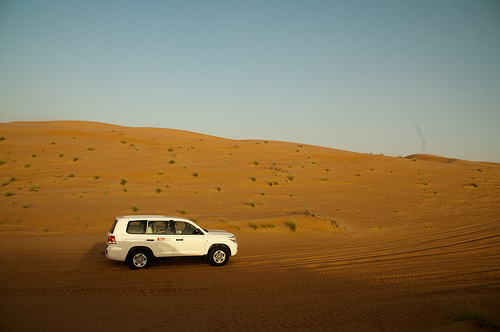By Jamilah Samian
[This article was written when the author was living with her family in the Middle East.]
Travelling almost 6,000km overland through sometimes harsh desert terrain with five children in tow may not be everybody’s idea of a holiday. But, for six-month pregnant Jamilah Samian, this one came with a bonus. For their destination was the holy city of Mecca. Today, on the eve of Hari Raya Haji, she shares with us the excitement and reverence of the 15-day trip.
And so it was decided. We would travel by land from Muscat, Oman, to Mecca to perform the umrah (minor pilgrimage).
We had first contemplated making the journey when my husband Fakhri was offered a cross-posting in a multinational company in Muscat over a year ago.
Although both of us had performed the hajj back in 1988, it had been our dream ever since to revisit the holy city with the children.
Barely two months after we set foot in the Gulf, and hardly had we settled down, the question was posed to us by my husband’s Omani colleague Jumea Al-Harthy and his wife, Awatif: Would we like to join their family on a land trip to Mecca in the coming summer?
It was only our second meeting with them and the offer took us completely by surprise. Although we had been reassured on how smooth the road leading to Mecca was, the fact remained that vast expanses of land through which the road ran are actually uninhabited.
Travelling in summer would pose its own perils, too. We would have to deal with soaring temperatures running to 50C in unfriendly terrain.
The international driving license I possessed was not recognised in Oman. Besides, women are not allowed to drive in Saudi Arabia. This meant that Fakhri would have to be the sole driver. Stops are few and far between and if we ran into trouble, getting assistance would be no easy task.
I would also be quite heavily pregnant by the time we made the journey.
Needless to say, we were most concerned about the safety aspects. Would we be able to endure the grueling journey?
A few weeks passed. But the more we thought about the matter, the more convinced we were that this was indeed a once-in-a-lifetime chance. The fact that Jumea had made the trip on two previous occassions with his colleagues made us confident.
Almost immediately, the frenzy of getting things done started. Ten years ago, when we wanted to perform the Hajj, all we did was register with the Lembaga Urusan dan Tabung Haji in Kuala Lumpur, settle the payment and attend some familiarization courses.
Now it was a totally different story. We had to apply for visas for three different countries, namely the United Arab Emirates, Saudi Arabia and Bahrain.
Although Saudi Arabia is next to Oman, there is no road system linking the two countries and we would have to use the coastal road, passing through the UAE before reaching Saudi Arabia.
Oh, the bureaucracy involved! Each country had its own visa application requirements. Saudi Arabia’s visa application form had to be translated to Arabic, Bahrain’s must be type-written. It took hours merely to sort out these essentials, not to mention the many trips to the respective embassies.
A month before the agreed departure date, the four of us adults sat down and drew a detailed plan and compiled a list of provisions. We had wanted to travel light yet essentials had to include cooking utensils, medical supplies, collapsible tent, potable water and dry food. And oh, a roof carrier, battery cable jumper, towing wire rope and road maps.
D-Day came. July 30, 1998. At 5am our home in Dhiab Street was a bustle of activity. The kids, all hyped up, were easily aroused from sleep. The sun was shining brightly as we set off after a brief prayer.
It was a smooth ride and we reached the UAE checkpoint at Buraimi about three hours later. Processing proved rather brisk and it took merely 15 minutes to clear immigration.
A quick snack followed before we pressed on towards Sila, 400km away, the UAE exit checkpoint before stepping on Saudi soil. By now, the kids were keeping themselves entertained with the board games and toys they had brought along.
Although the vehicle’s air-conditioning system was working well, we had no illusions about the soaring temperature outside as could be seen by the mirages that loomed endlessly ahead of us. By then, we were going at an average speed of 140km/hr.
On reaching Sila, we spotted a decent restaurant to have our lunch. The scorching sun relentlessly hit our faces as we dashed from the vehicles to the booked family room. It was time to feast on the fare we had brought from home.
It is common for restaurants in this region to have separate family rooms as womenfolk here normally adorn veils that would make it difficult to enjoy meals in public.
Laughter filled the room as someone remarked that the silence was a dead giveaway to how famished we were!
I was buoyed by a great feeling of camaraderie as we took our seats to share the rendang and nasi lemak and taste the Swahili pilau rice that our Omani companions had prepared.
By the time we arrived at the Saudi Arabian checkpoint, there were hordes of vehicles ahead. As the men went to get the passports stamped, we downed plenty of cold drinks which provided some respite against the blazing sun.
The waiting game ended a good two hours later, but everyone was in high spirits despite being drenched in sweat as we took off again.
I presume most of us have a stereotype idea of how deserts look like. I, for one, had been told that there was practically “nothing of interest there”.
This was not altogether true as deserts differ. While some offer gentle, wavy slopes of sand dunes, others have great stony structures in shades of green, black and orange.
Natural vegetation is sparse, but the efforts of some countries to green the environment, notably Oman, are commendable.
We finally descended upon Al-Hafof, the next rendezvous, at about 8pm. Night had set in. Fortunately, we successfully secured two apartments at fairly reasonable rates. We had clocked 1,100km in 14 hours on the first day.
The experience had taught us one valuable lesson: To arrive at an unfamiliar destination after dark is not a very wise thing to do. Not all the streets were lit and road signs were difficult to decipher. We were determined to reach Medina before dusk the next day, so we set off shortly after daybreak.
Soon, the greenery and edifices of Al-Hafof tapered off and gave way to a seemingly endless sea of sand. No shelter was to be seen for miles. A tingle of fear crept up and I quietly prayed.
At a certain stretch of the highway, road signs appeared cautioning motorists to beware of camels crossing. Sure enough, herds of them began to appear some distance away. We had a close encounter with one animal when it decided to cross the path with our very eyes with a Bedouin perched on top. My, wasn’t it huge!
Both drivers were exhausted. The roasting heat was too much to endure. I was dozing off when Fakhri said he was sleepy. Wedged between the driver’s seat and mine was a mini-freezer. I groped for a bottle of cold water to splash on my husband’s face.
Soon, we found ourselves crossing the 10km mark towards Medina. The children cheered as the audio system reverberated with a song by popular Malaysian nasyid group Raihan.
There was a sudden surge of adrenalin as the countdown began. The first roundabout at Medina came into full view shortly. Minutes later, a service station that resembled a space station caught our attention. Before us, the minarets of the Prophet’s Mosque rose majestically in awesome grandeur.
The next three days saw us courting the mosque which was a mere two-minute walk from our modest two-bedroom quarters. The lofty ceilings and cool marble floors evoked an aura of peace and tranquility as we stood before the Prophet’s burial chamber.
On the second day, we rented a bus and called on the more significant historical grounds.
The moment came soon to bid farewell as we still had to pursue our final destination. The route to Mecca, 400km away, didn’t seem too daunting in comparison to the few thousand kilometres we had conquered.
But first, we had to dorn the special umrah garb at a small town called Bir Ali, 350km from Mecca. As the men took their shower, the rest of us took stock of the mosque which was equipped with 1,000 bathrooms.
It was difficult to keep our emotions in check as we entered the gates of the holy city. This was the moment we had waited for the last two months; nay, the past ten years.
Joy overwhelmed us as we soaked in the sights and smells. Despite it being an off-peak season, the narrow avenues of Mecca were choking with traffic. Our lodgings found, we got down to performing the umrah that very afternoon.
The kids were visibly struck with awe as they gazed at the magnificent Kaabah draped in dark green silk. An ambience of reverence prevailed as we purposefully strode down the steps towards it. It was quite unlike the hajj season when throngs of pilgrims would flock the site. Still, there was quite a crowd.
We were initially concerned that the presence of the children might hamper the smooth course of the pilgrimage but our fears proved unfounded. They were cooperative, having been briefed on the significance of all the deeds we had to accomplish.
Before we knew it, the moment came to pack and head for home. Our hearts were heavy as we said our final goodbyes. We did not envision making the passage again in the near future, and so took the opportunity to visit some other metropolis on our way home,including the sprawling city of Riyadh.
Here, we brought the kids to the zoo before heading for Dammam’s family amusement park. This was followed by the sovereign island of Bahrain.
Fifteen days from the day we started our adventure, we again crossed the border ofOman. We had trekked almost 6,000km and despite the overwhelming weariness, elation filled everyone as we finally reached home. We did it!
Published in Life & Times, New Straits Times, 2000



